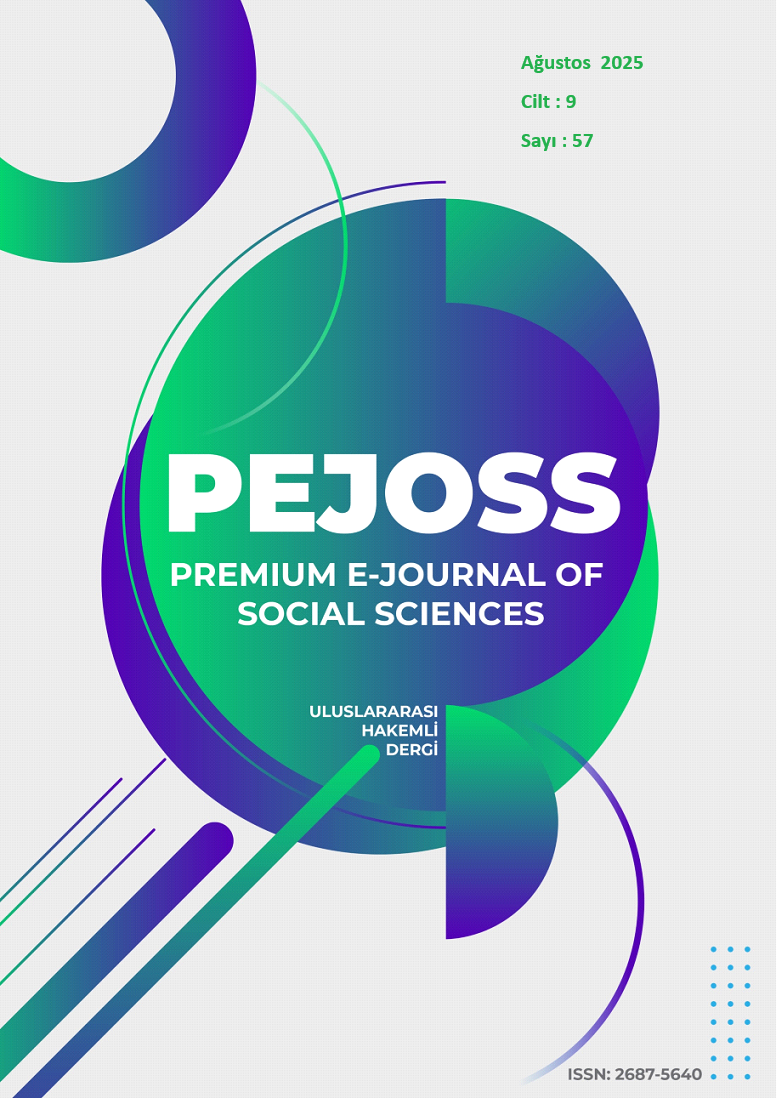Sectoral Functional Strategies and Competitive Forces: A Case Study in Footwear Manufacturing
DOI:
https://doi.org/10.5281/zenodo.17014183Keywords:
Competitive strategies, footwear industry, SMEAbstract
This study examines the impact of competitive dynamics on production strategies in manufacturing enterprises, using Porter’s Five Forces Model as a framework and focusing on an SME operating in the footwear production sector. As a labor-intensive and low-tech industry, this sector sees its production processes from design to distribution significantly influenced by external competitive factors. A qualitative research method was adopted, with data collected through semi-structured interviews analyzing participants' experiences and observations. Findings indicate that customer bargaining power is the most influential competitive force in the sector, followed sequentially by supplier power, the threat of substitute products, and rivalry among existing competitors. Additionally, factors such as early-stage design processes, the use of natural materials, and supply chain policies directly shape production strategies.
The intensity of competition in the sector has increased due to the presence of low-cost global manufacturers, pushing local producers toward cost optimization and innovation while emphasizing quality and sustainability as key consumer preferences. Rising customer bargaining power forces firms to adopt flexible production and customized product offerings. Supplier power plays a critical role due to raw material quality, price volatility, and challenges in sourcing premium materials like genuine leather. The threat of substitutes has grown with the proliferation of synthetic materials and fast fashion trends, compelling manufacturers to blend traditional and modern designs for differentiation. Intra-industry rivalry remains multidimensional, involving competition over pricing, quality, distribution channels, and brand perception. The study highlights how competitive forces shape sector-specific production decisions and recommends future research to explore supplier perspectives, managerial strategies, and the impact of digital transformation on competitive dynamics. Sustainable production models should also be evaluated for their potential to create a competitive advantage.
Downloads
References
Adewole, A. (2005). Developing a strategic framework for efficient and effective optimisation of information in the supply chains of the UK clothing manufacture industry. Supply Chain Management: An International Journal, 10(5), 357-366. https://doi.org/10.1108/ 13598540510624188
Agwu, M. E., & Onwuegbuzie, H. (2017). Strategic importance of functional level strategies as effective tools for the achievement of organizational goals. Archives of Business Research, 5(12).
Ağraş, S., & İnanoğlu, A. (2022). Üretim stratejilerinin belirlenmesinde rekabetçi güçlerin rolü. Düzce Üniversitesi Sosyal Bilimler Dergisi, 12(2), 697-716.
Altunışık, R., Coşkun, R., Bayraktaroğlu, S., & Yıldırım, E. (2010). Sosyal bilimlerde araştırma yöntemleri SPSS uygulamalı. Sakarya: Sakarya Yayıncılık, 7-253.
Arabnarmi, B., Kheybari, S., Amiri Ali Akbar Khani, S., & Ishizaka, A. (2024). Integration of organizational, economic and customer-related attributes to prioritize marketing strategies. Journal of Business & Industrial Marketing, 39(10), 2222-2238.
Brunsman, B., DeVore, S., & Houston, A. (2011). The corporate strategy function: improving its value and effectiveness. Journal of business strategy, 32(5), 43-50.
Ciucescu, N., Ceocea, C., Turcu, O.-L., Feraru-Prepeliță, A., & Ceocea, R.-A. (2022). Aspects regarding functional strategies in romanian organizations. Studies and Scientific Researches. Economics Edition (35), 41-48. https://doi.org/https://doi.org/10.29358/sceco.v0i35.508
Çubukcu, M. (2018). İşletmelerde uygulanan strateji tipleri ve uygulamadan örnekler. Uluslararası Yönetim Akademisi Dergisi, 1(2), 142-156.
Diane, I., Kevin, H., Sarah, M., & Chiara, P. (2020). Is Porter's Five Forces Framework Still Relevant? A study of the capital/labour intensity continuum via mining and IT industries. Technology Innovation Management Review, 10(6). timreview.ca/article/1366
Dömbekci, H. A., & Erişen, M. A. (2022). Nitel araştırmalarda görüşme tekniği. Anadolu Üniversitesi Sosyal Bilimler Dergisi, 22 (Özel Sayı 2), 141-160.
Grünig, R., & Kühn, R. (2015). Developing the Functional Strategies. In R. Grünig & R. Kühn (Eds.), The Strategy Planning Process: Analyses, Options, Projects (pp. 239-246). Springer Berlin Heidelberg. https://doi.org/10.1007/978-3-662-45649-1_21
Indrarathne, P., Ranadewa, K., & Shanika, V. (2020). Impact of competitive forces to the contractors in sri lanka: an industry analysis using porter’s five forces. 13th International Research Conference-FARU, Sri Lanka.
Kahya, M. (2020). Rekabetçi Atalet, İşlevsel Stratejiler ve Geçici Rekabet Avantajı: Kavramsal Bir Değerlendirme. Stratejik Yönetim Araştırmaları Dergisi, 3(2), 208-234.
Karagiannopoulos, G. D., Georgopoulos, N., & Nikolopoulos, K. (2005). Fathoming Porter's five forces model in the internet era. info, 7(6), 66-76. https://doi.org/10.1108/14636690510628328
Lethbridge, J. (2011). Understanding multinational companies in public health systems, using a competitive advantage framework. Globalization and Health, 7(1), 19. https://doi.org/10.1186/1744-8603-7-19
Mackay, D., Arevuo, M., Meadows, M., Mackay, D., Arevuo, M., & Meadows, M. (2023). Strategy Theory, Practice, Implementation: Theory, Practice, Implementation. In Functional Strategy and Performance. Oxford University Press. https://doi.org/10.1093/hebz/9780192845399.003.0012
Mihaylova, L., & Papazov, E. (2024). Strategic Management of Small and Medium-Sized Enterprises-Is There Space for Functional Strategies? TEM Journal, 13(2), 1277.
Nag, B., Han, C., & Yao, D.-q. (2014). Mapping supply chain strategy: an industry analysis. Journal of Manufacturing Technology Management, 25(3), 351-370. https://doi.org/10.1108/JMTM-06-2012-0062
Porter, M. E. (1979). The five competitive forces that shape strategy. Harvard business review, 57(2), 137-145.
Rajasekar, J., & Al Raee, M. (2013). An analysis of the telecommunication industry in the Sultanate of Oman using Michael Porter's competitive strategy model. Competitiveness Review: An International Business Journal, 23(3), 234-259. https://doi.org/10.1108/10595421311319825
Sağır, M. (2010). Stratejik yönetim sürecinde ürün stratejilerinin kullanımı ve önemi. Selçuk Üniversitesi Sosyal Bilimler Enstitüsü Dergisi(24), 311-321.
Somov, D. (2018). The functional approach to strategic management. Economic Annals-XXI, 171(5-6), 19-22.
Türnüklü, D. A. (2000). Eğitimbilim Araştırmalarında Etkin Olarak Kullanılabilecek Nitel BirAraştırma Tekniği: Görüşme. Kuram ve Uygulamada Eğitim Yönetimi, 24(24), 543-559.
Ülgen, H., & Mirze, S. K. (2013). İşletmelerde Stratejik Yönetim. Beta Yayınları.
Wang, W., & Chang, P. P. (2009). Entrepreneurship and strategy in China: why “Porter's five forces” may not be. Journal of Chinese Entrepreneurship, 1(1), 53-64. https://doi.org/10.1108/ 17561390910916886
Yıldırım, A., & Şimşek, H. (2008). Sosyal Bilimlerde Nitel Araştırma Yöntemleri. Seçkin Yayıncılık.
Downloads
Published
How to Cite
Issue
Section
License
Copyright (c) 2025 Premium e-Journal of Social Science (PEJOSS)

This work is licensed under a Creative Commons Attribution 4.0 International License.


